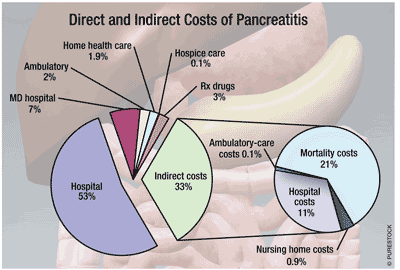US Pharm. 2010;35(6):6.
Pancreatitis occurs more often in men than in women. Acute pancreatitis (17 new cases per 100,000) may be life-threatening and has a greater burden of medical care and mortality compared with chronic pancreatitis. Each year, 333,000 people are admitted to the hospital with acute pancreatitis. Commonly, chronic pancreatitis develops in people aged 30 to 40 years. Hereditary pancreatitis may present in patients younger than 30 years, but the condition might not be diagnosed for several years. Rates of ambulatory-care visits and hospitalizations for pancreatitis increased from the 1980s to 2004.

Ambulatory Care, Hospitalization, and Mortality: One of the largest individual disease contributions to the increase in ambulatory-care visits from 1998 to 2004 was made by pancreatitis, at a rate of 23 per 100,000 visits. In 2004, there were 881,000 ambulatory-care visits for pancreatitis, and the rate of such visits increased moderately with age. Rates were 25% higher among African American patients than white patients and 52% higher among women versus men.
Between 1988 and 2004, the rate of hospital discharges with a diagnosis of pancreatitis increased 62%, to a total of 454,000. Hospitalization rates, which increased with age, were 88% higher among African American patients and 11% higher among men.
In 2004, more than half of deaths from pancreatitis occurred among patients aged 65 years and older. Death rates, which increased with age, were higher among African American patients and among men. Mortality rates fell slightly from 1979 to 2004, with the rate for the underlying cause dropping by 15%.
Prescriptions: According to the Verispan database, in 2004 the total number of prescriptions filled for pancreatitis was 766,000, at a retail cost of $88.6 million. Pancreatic-enzyme replacements constituted 60.3% of prescriptions and 84.8% of the cost. All other prescriptions filled for pancreatitis were analgesics or antiemetics.
The most commonly prescribed drug product for pancreatitis was amylase/lipase/protease; at a retail cost of $55 million, this product accounted for 62% of the cost of all prescriptions dispensed for the treatment of pancreatitis. Pancrelipase followed, accounting for 24% of the cost. Hydrocodone/acetaminophen came in third, accounting for 8% of the cost, and the fourth position was held by oxycodone/acetaminophen, at 5% of the cost.
Costs: Pancreatitis was one of the four most significant causes of lost wages during hospital stays. The indirect cost was $1,187, with hospital stay and ambulatory care costing $398 million and $13 million, respectively. Mortality due to pancreatitis alone cost $775.9 million in indirect costs.
To comment on this article, contact rdavidson@uspharmacist.com.






